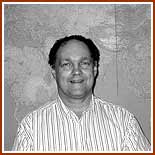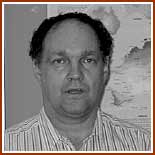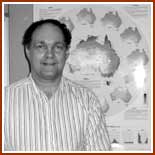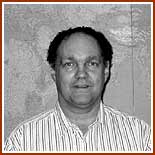 |
|
 "On Black Friday the temperature reached 45.6 degrees, the highest temperature Melbourne has ever had."  "Really bad bushfires depend on two things, antecedent drought and diabolical weather conditions on the day."  "At first the winds seemed apocalyptic.You had trees uprooted and thrown out of the ground."  "There are phenomena such as fire tornadoes which can be generated in huge bushfires. The í39 fires probably triggered off a few of those."  "The fires in Victoria at the moment have generated their own thunderstorms and could have been igniting other fires." |
Bill Wright Climatologist - Bureau of Meteorology  On the day of the worst of the bush fires, Black Friday itself - 13th January - the Melbourne temperature reached 45.6 degrees which remains the highest temperature Melbourne has ever had, but there were other very hot days in the preceding week. There was 43.8 on the 8th of January and then 44.7 on the 10th of January, and just by comparison, Melbourne in the summer of 2002/03 had 44.1 which is the hottest temperature that has occurred since the Black Friday fires. But the sheer heat, coming on top of a really long dry period and that strong, gusty northerly that everyone knows and fears and hates, in Melbourne. They all came together and many of the fires burning already in the week preceding Black Friday just got completely out of control when Black Friday dawned and razed huge areas of forest.  At first the winds seemed a bit
apocalyptic, in that you had trees uprooted and thrown out of the ground. I didnít know a lot about the science of bush fires at that time, and I
still donít, in fact no one really understands a great deal about the bushfire science at that time, thatís one reason why a corporate research centre for bushfire research is being established. Last year it was being set up,
in 2004 it will go into production, and Iím taking part in that. At first the winds seemed a bit
apocalyptic, in that you had trees uprooted and thrown out of the ground. I didnít know a lot about the science of bush fires at that time, and I
still donít, in fact no one really understands a great deal about the bushfire science at that time, thatís one reason why a corporate research centre for bushfire research is being established. Last year it was being set up,
in 2004 it will go into production, and Iím taking part in that.A lot of the science as yet isnít known, but one thing that I have found out since first becoming interested in the 1939 bushfires is a phenomenon such as blow-up situations. Blow-up situations or firestorms as theyíre sometimes called, is when fires just get completely out of control, and no one really knows why those occur. Itís been hypothesised that it might be when two fire fronts converge and you get just special conditions occurring and there are phenomena such as fire tornados which can be generated in huge bushfires. And Iím inclined to believe that the fires themselves, the 1939 bushfires, probably triggered off a few of those. Thereís an interesting story about those incidentally. I havenít been able to check whether itís completely true, but apparently Fujita, the Japanese scientist who developed the tornado scale, which is in use today, the F1, F5, if youíve seen Twister youíll probably understand that. He was investigating the aftermath of the Hiroshima bombing in í45 and the huge fire-storms that were created by the atom bomb. Several of these fire tornados were set up then and he became interested in tornados at that point.  You need huge conflagrations to develop these tornados and they can have tremendous wind speeds and tremendous upwards wind speeds as well and can do tremendous
damage. But fires create their own winds anyway, you get tremendous flows into and out of the fires and that can create freak effects. You need huge conflagrations to develop these tornados and they can have tremendous wind speeds and tremendous upwards wind speeds as well and can do tremendous
damage. But fires create their own winds anyway, you get tremendous flows into and out of the fires and that can create freak effects.I donít like to over-exaggerate the dangers that can be associated with fires. Most of these of course have logical explanations. One thing the Centre for Bushfire Research will try to do, will be to separate the science from myth as it were. But thereís no doubt that these fire twisters occurred, no doubt that huge fires generate their own wind and weather patterns. The fires that weíve just been experiencing in Victoria at the moment, have been apparently generating even their own thunder storms which have been - and again this isnít proven, itís just hearsay, theyíre things that weíve got to look at - but itís believed that those generated thunder storms could have been igniting other fires. So you had the more general effect called spotting where huge fires produce a tremendous convection column of fiercely rising hot air, that fiercely rising hot air, carries with it burning leaves and small branches and things, they get caught in the generally strong winds that are aloft, and carried anything from tens of metres to as much as 15 kilometres ahead of the main fire. Of course, they are enormously dangerous because they can jump over control lines and start blazes behind the control lines and start fires in inaccessible areas, and theyíre the things that are responsible for the burning down of most houses, as the fires lodge in peopleís roof gutters, or get under the house, or ignite dry vegetation next to the house, and then if thereís no one there to put those out, the house quickly burns down.  Really bad bush fires, seem to depend on two things
really. One is antecedent climate conditions, in particular rain fall and very dry conditions such as we experienced
recently in a lot of Australia. They dry out the vegetation, they dry out the subsoil, they result in water storages dropping, and the whole water table dropping, so shrubs and grass and in the worse case, even trees start to
die. They become very dry and very flammable, and of course thereís no moisture in things that might act as a bit of a break to any fire that gets going. Really bad bush fires, seem to depend on two things
really. One is antecedent climate conditions, in particular rain fall and very dry conditions such as we experienced
recently in a lot of Australia. They dry out the vegetation, they dry out the subsoil, they result in water storages dropping, and the whole water table dropping, so shrubs and grass and in the worse case, even trees start to
die. They become very dry and very flammable, and of course thereís no moisture in things that might act as a bit of a break to any fire that gets going.So thatís the first thing - antecedent dry conditions. We had that in 1939. We had extremely dry conditions in the second half of 1938 and well into January and the second thing is the associated weather conditions that are needed for bad fires, and they feature hot conditions with very low humidity and particularly strong winds. All three of those are very important, arguably perhaps the wind is the most important, and on Black Friday, it was the same on other bad days such as Ash Wednesday, you had all of those conditions together. You had antecedent drought and you had absolutely diabolical conditions on the day. So the weather conditions are absolutely critical because they first of all prime the situation and then they act to encourage the extremely bad bushfire behaviour on the day. I joined the Bureau in 1988 and I was a forecaster for three years, and was actually doing fire weather forecasting as part of that, and so I learned a little bit about the science of weather forecasting and fire forecasting. The other incidence that increased my interest in fire was moving into a fire-prone area in the Dandenongs in Victoria. We were pretty blasť about it in the early 90s which had a run of wet summers, but in the summer of í94 and í95 we had a treacherous season and then three years later, in early í97, there were severe bushfires in the Dandenongs in which three people were killed. So that really sort of sent a bit of a jolt through me and the rest of the community. Even in a bad season and really hot days, youíd tend to be a bit blasť about it, but on this occasion, it was enough to strike the fear of God into you. So there was a little bit of a taste then, but the 1939 fires, they burned a much larger area. They were the sort of fires that takes on almost a mythological status, like cricket with Don Bradman, where you hear about his reputation before youíve even seen him. The 1939 fires have a fearsome reputation. Just the sheer ferocity of the fires, they were accompanied by the worst possible weather that you could imagine. |
The Scientists
Bill Wright
Climatologist Bureau of Meteorology David Packham Fire Managment Consultant, Indonesia David Ashton Doctor of Science, expert on the mountain ash forests Mike Reeder Reader in Applied Mathematics at Monash University. Kevin Tolhurst Fire ecologist based at University of Melbourne, Creswick Campus |
 |